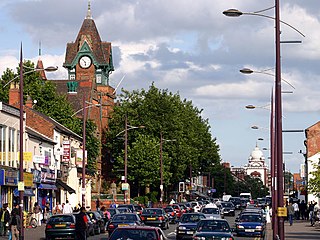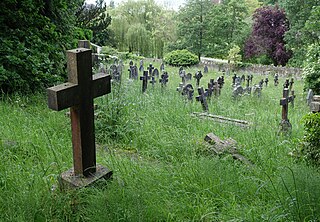
Great Barr Hall is an 18th-century mansion situated in the Great Barr district of Pheasey, Walsall, West Midlands, England. It has associations with the Lunar Society and is a Grade II listed building. It is, however, in a very poor state of repair and is on the Buildings at Risk Register.

Handsworth is an inner-city area of Birmingham in the West Midlands, England. Historically in Staffordshire, Handsworth lies just outside Birmingham City Centre and near the town of Smethwick.

St Mary's Church, Handsworth, also known as Handsworth Old Church, is a Grade II* listed Anglican church in Handsworth, Birmingham, England. Its ten-acre (4 hectare) grounds are contiguous with Handsworth Park. It lies just off the Birmingham Outer Circle, and south of a cutting housing the site of the former Handsworth Wood railway station. It is noteworthy as the resting place of famous progenitors of the industrial age, and has been described as the "Cathedral of the Industrial Revolution".

Arnos Vale Cemetery, in Arnos Vale, Bristol, England, was established in 1837. Its first burial was in 1839. The cemetery followed a joint-stock model, funded by shareholders. It was laid out as an Arcadian landscape with buildings by Charles Underwood. Most of its area is listed, Grade II*, on the Register of Historic Parks and Gardens of special historic interest in England.

Julius Alfred Chatwin FRIBA, ARBS, FSAScot was a British architect. He was involved with the building and modification of many churches in Birmingham, and practised both Neo-Gothic and Neo-Classical styles. His designs always included all of the carvings and internal fittings.

William Henry Bidlake MA, FRIBA was a British architect, a leading figure of the Arts and Crafts movement in Birmingham and Director of the School of Architecture at Birmingham School of Art from 1919 until 1924.

Holland William Hobbiss, was an English architect in the Birmingham area. He traded under the names Holland W. Hobbiss and Partners and Holland W. Hobbiss and M. A. H. Hobbiss.

Intake is a suburb and former village located 5 miles (8 km) south-east of Sheffield city centre, South Yorkshire, England. Due to expansion during the 20th century, the village became a part of the city of Sheffield. Intake is linked to Frecheville via Birley Moor Road, and to Gleadless via Hollinsend Road.

The cemetery has had various titles including The Cemetery by the Common, Hill Lane Cemetery and is currently known as Southampton Old Cemetery. An Act of Parliament was required in 1843 to acquire the land from Southampton Common. It covers an area of 27 acres (11 ha) and the total number of burials is estimated at 116,800. Currently there are 6 to 8 burials a year to existing family plots.
Edward Holmes (1832–1909) was a British architect from Birmingham, England.

The City of London Cemetery and Crematorium is a cemetery and crematorium in the east of London. It is owned and operated by the City of London Corporation. It is designated Grade I on the Historic England National Register of Historic Parks and Gardens.

The Lye and Wollescote Cemetery is an active 9.45 acres (3.82 ha) cemetery in Lye, West Midlands, England.

Brandwood End Cemetery is a cemetery located in the Brandwood ward of Birmingham, England.
The Lancaster Cemetery Chapels are the three chapels, each built to serve a different denomination, in the main cemetery of Lancaster, England. The chapels stand around a central point at the highest part of the cemetery. They were all built in 1854–55, and were designed by the local architect E. G. Paley. The chapel to the west of the central point served the Anglicans, that to the east the Non-conformists, and the chapel to the north was for Roman Catholics.

St Mary's Convent is a house for the community of the local Sisters of Mercy in Birmingham. Although it is situated between the Lozells and Hockley parts of the city, the community also serves the parish in Handsworth. It was founded in 1840 and was designed by Augustus Pugin. On 25 April 1952 it was designated as a Grade II* listed building by English Heritage.

St Andrew's Church, Handsworth is a Grade I listed parish church in the Church of England in Handsworth, West Midlands.

St James' Church in Handsworth, Birmingham, England was erected as an Anglican church in 1838–1840 on land given by John Crockett of the nearby New Inns Hotel. The architect was Robert Ebbles of Wolverhampton, who specialised in Gothic Revival churches. A new chancel was added in 1878 and the building was rebuilt in 1895, to designs by J. A. Chatwin. The original chancel thus became the north chapel, the original nave became the north aisle, and the original western tower was redesignated as the north-west tower. The additions were a new chancel, a nave, and a south aisle. Chatwin's Decorated style, red-brick features contrasted with the Early English style stonework of the original building.

Smallcombe Cemetery is on the edge of Bath, Somerset, England, in a valley between Widcombe Hill and Bathwick Hill. It has two distinct parts, the Anglican section known as St Mary's Churchyard and the nonconformist section known as Smallcombe Vale cemetery; they are sometimes known together as Smallcombe Garden cemetery. The two cemeteries have been closed to new burials since 1988 and are maintained by Bath and North East Somerset Council. The Bath Corporation had assumed responsibility for both cemeteries in 1947.

Holy Trinity Church is a Grade II* listed parish church in the Church of England in Birchfield, Birmingham. The church building was placed on a Heritage at Risk Register due to its poor condition in 2018, but repairs led to its removal from this register.

The Red Lion is a disused public house on Soho Road, in the Handsworth district of Birmingham, England.



















